The Impact of Temperature of the Tripping Thresholds of Intrusion Detection System Detection Circuits
Abstract
:1. Introduction
- communications,
- ICT networks,
- financial [4],
- food supply,
- water supply,
- health care,
- emergency services,
- ensuring continuity of the public administration operation,
- production, deposition, storage and the use of chemicals and radioactive substances (including pipelines with hazardous substances).
- CCTV system [16],
2. Literature Review
3. Materials and Methods
4. Results
5. Discussion and Conclusions
Author Contributions
Funding
Institutional Review Board Statement
Informed Consent Statement
Data Availability Statement
Conflicts of Interest
References
- Government Security Center. National Critical Infrastructure Protection Programme in Poland. August 2020. Available online: https://www.gov.pl/attachment/ee334990-ec9c-42ab-ae12-477608d94eb1 (accessed on 18 August 2021).
- An, J.; Mikhaylov, A.; Richter, U.H. Trade War Effects: Evidence from Sectors of Energy and Resources in Africa. Heliyon 2020, 6, e05693. [Google Scholar] [CrossRef]
- An, J.; Mikhaylov, A. Russian energy projects in South Africa. J. Energy South. Afr. 2020, 31, 58–64. [Google Scholar] [CrossRef]
- Mishina, V.Y.; Khomyakova, I.I. Dedollarization and settlements in national currencies: Eurasian and Latin American experience. Vopr. Ekon. 2020, 9, 61–79. [Google Scholar] [CrossRef]
- Gołębiowski, P.; Jacyna, M.; Stańczak, A. The Assessment of Energy Efficiency versus Planning of Rail Freight Traffic: A Case Study on the Example of Poland. Energies 2021, 14, 5629. [Google Scholar] [CrossRef]
- Jacyna, M.; Żochowska, R.; Sobota, A.; Wasiak, M. Scenario Analyses of Exhaust Emissions Reduction through the Introduction of Electric Vehicles into the City. Energies 2021, 14, 2030. [Google Scholar] [CrossRef]
- Losurdo, F.; Dileo, I.; Siergiejczyk, M.; Krzykowska, K.; Krzykowski, M. Innovation in the ICT Infrastructure as a Key Factor in Enhancing Road Safety: A Multi-Sectoral Approach. In Proceedings of the 2017 25th International Conference on Systems Engineering (ICSEng), Las Vegas, NV, USA, 22–24 August 2017; Selvaray, H., Chmaj, G., Zydek, D., Eds.; The Institute of Electrical and Electronics Engineers, Inc.: Danvers, MA, USA, 2017; pp. 157–162. [Google Scholar] [CrossRef]
- Kierzkowski, A.; Kisiel, T. Simulation model of security control system functioning: A case study of the Wroclaw Airport terminal. J. Air Transport. Manag. 2017, 64, 173–185. [Google Scholar] [CrossRef]
- Siergiejczyk, M.; Paś, J.; Dudek, E. Reliability analysis of aerodrome’s electronic security systems taking into account electromagnetic interferences. In Proceedings of the Safety and Reliability—Theory and Applications, Proceedings of the 27th European Safety and Reliability Conference (Esrel 2017), Portorož, Slovenia, 18–22 June 2017; Čepin, M., Briš, R., Eds.; CRC Press/Balkema: Schipholewh, The Netherlands, 2017; pp. 2285–2292. [Google Scholar] [CrossRef]
- Fischer, R.J.; Halibozek, E.P.; Walters, D.C. Introduction to Security, 10th ed.; Butterworth-Heinemann: Oxford, UK, 2019. [Google Scholar] [CrossRef]
- Purpura, P.P. Security and Loss Prevention: An Introduction; Butterworth-Heinemann: Oxford, UK, 2019. [Google Scholar] [CrossRef]
- Valouch, J. Technical requirements for Electromagnetic Compatibility of Alarm Systems. Int. J. Circuits Syst. Signal Process. 2015, 9, 186–191. Available online: https://www.naun.org/main/NAUN/circuitssystemssignal/2015/a522005-196.pdf (accessed on 10 July 2021).
- Urbancokova, H.; Valouch, J.; Adamek, M. Testing of an intrusion and hold-up systems for electromagnetic susceptibility—EFT/B. Int. J. Circuits Syst. Signal Process. 2015, 9, 40–46. Available online: https://www.naun.org/main/NAUN/circuitssystemssignal/2015/a122005-024.pdf (accessed on 10 July 2021).
- Wiśnios, M.; Paś, J. The assessment of exploitation process of power for access control system. E3S Web Conf. 2017, 19, 01034. [Google Scholar] [CrossRef] [Green Version]
- Wiśnios, M.; Dąbrowski, T.; Bednarek, M. The security increasing level method provided by biometric access control system. Przegląd Elektrotechniczny 2015, 91, 229–232. [Google Scholar] [CrossRef]
- Paś, J.; Rosiński, A.; Białek, K. A reliability-operational analysis of a track-side CCTV cabinet taking into account interference. Bull. Pol. Acad. Sci. Tech. Sci. 2021, 69, e136747. [Google Scholar] [CrossRef]
- Klimczak, T.; Paś, J. Basics of Exploitation of Fire Alarm Systems in Transport Facilities; Military University of Technology: Warsaw, Poland, 2020. [Google Scholar]
- Jakubowski, K.; Paś, J. Determination of the performance parameters of selected electronic safety systems based on the process of their use in critical infrastructure facilities. Przegląd Elektrotechniczny 2021, 97. [Google Scholar] [CrossRef]
- Paś, J.; Klimczak, T. Selected issues of the reliability and operational assessment of a fire alarm system. Eksploat. I Niezawodn. Maint. Reliab. 2019, 21, 553–561. [Google Scholar] [CrossRef]
- Krzykowska-Piotrowska, K.; Dudek, E.; Siergiejczyk, M.; Rosiński, A.; Wawrzyński, W. Is Secure Communication in the R2I (Robot-to-Infrastructure) Model Possible? Identification of Threats. Energies 2021, 14, 4702. [Google Scholar] [CrossRef]
- Jacyna, M.; Szczepański, E.; Izdebski, M.; Jasiński, S.; Maciejewski, M. Characteristics of event recorders in Automatic Train Control systems. Arch. Transport 2018, 46, 61–70. [Google Scholar] [CrossRef]
- Polak, R.; Laskowski, D.; Matyszkiel, R.; Łubkowski, P.; Konieczny, Ł.; Burdzik, R. Optimizing the Data Flow in a Network Communication between Railway Nodes. In Research Methods and Solutions to Current Transport Problems, Proceedings of the International Scientific Conference Transport of the 21st Century, Advances in Intelligent Systems and Computing, Ryn, Poland, 9–12 June 2019; Siergiejczyk, M., Krzykowska, K., Eds.; Springer: Cham, Switzerland, 2020; Volume 1032, pp. 351–362. [Google Scholar] [CrossRef]
- Kossakowski, D.; Krzykowska, K. Application of V2X Technology in Communication between Vehicles and Infrastructure in Chosen Area. In Research Methods and Solutions to Current Transport Problems, Proceedings of the International Scientific Conference Transport of the 21st Century, Advances in Intelligent Systems and Computing, Ryn, Poland, 9–12 June 2019; Siergiejczyk, M., Krzykowska, K., Eds.; Springer: Cham, Switzerland, 2020; Volume 1032, pp. 247–256. [Google Scholar] [CrossRef]
- Klimczak, T.; Paś, J. Reliability and operating analysis of transmission of alarm signals of distributed fire signaling system. J. KONBiN 2019, 49, 165–174. [Google Scholar] [CrossRef] [Green Version]
- Bednarek, M.; Dąbrowski, T.; Olchowik, W. Selected practical aspects of communication diagnosis in the industrial network. J. KONBiN 2019, 49, 383–404. [Google Scholar] [CrossRef] [Green Version]
- Paś, J.; Rosiński, A.; Białek, K. A reliability-exploitation analysis of a static converter taking into account electromagnetic interference. Transport Telecommun. 2021, 22, 217–229. [Google Scholar] [CrossRef]
- Paś, J.; Jakubowski, K. Indicator Analysis of Security Risk for Electronic Systems Used to Protect Field Command Posts of Army Groupings. J. KONBiN 2020, 50, 43–61. [Google Scholar] [CrossRef]
- Chmielińska, J.; Kuchta, M.; Kubacki, R.; Dras, M.; Wierny, K. Selected methods of electronic equipment protection against electromagnetic weapon. Przegląd Elektrotechniczny 2016, 92, 1–8. [Google Scholar] [CrossRef]
- Stypułkowski, K.; Gołda, P.; Lewczuk, K.; Tomaszewska, J. Monitoring System for Railway Infrastructure Elements Based on Thermal Imaging Analysis. Sensors 2021, 21, 3819. [Google Scholar] [CrossRef]
- Polish-European Standard. PN-EN 50131-1:2009. Alarm Systems—Intrusion and Hold-up Systems—Part. 1: System Requirements; Polish Committee for Standardization: Warsaw, Poland, 2009. [Google Scholar]
- Xu, S.; Li, X. Analysis on thermal reliability of key electronic components on PCB board. In Proceedings of the 2011 International Conference on Quality, Reliability, Risk, Maintenance, and Safety Engineering, Xi’an, China, 17–19 June 2011; Huang, H.-Z., Zuo, M.J., Jia, X., Liu, Y., Eds.; IEEE: Xi’an, China, 2011; pp. 52–54. [Google Scholar] [CrossRef]
- Milic, M.; Ljubenovic, M. Arduino-Based Non-Contact System for Thermal-Imaging of Electronic Circuits. In Proceedings of the 2018 Zooming Innovation in Consumer Technologies Conference (ZINC), Novi Sad, Serbia, 30–31 May 2018; pp. 62–67. [Google Scholar] [CrossRef]
- Shilo, G.; Ogrenich, E.; Kulyaba-Kharitonova, T.; Buhaiev, O. Thermal design of the Electronic Equipment Enclosures with Natural Air Cooling. In Proceedings of the 9th International Conference on Advanced Computer Information Technologies (ACIT), Ceske Budejovice, Czech Republic, 5–7 June 2019; pp. 153–156. [Google Scholar] [CrossRef]
- Qiang, G.; Ya, Z.; Jinhua, Z. Dynamic Reliability Testing about Temperature Characteristic of Components. In Proceedings of the 2009 International Conference on Wireless Networks and Information Systems, Shanghai, China, 28–29 December 2009; Luo, Q., Tan, H., Eds.; IEEE: Los Alamitos, CA, USA, 2009; pp. 257–258. [Google Scholar] [CrossRef]
- Vasile, D.C.; Svasta, P.M. Temperature sensitive active tamper detection circuit. In Proceedings of the 2017 IEEE 23rd International Symposium for Design and Technology in Electronic Packaging (SIITME), Constanta, Romania, 26–29 October 2017; IEEE: Piscataway Township, NJ, USA, 2017; pp. 175–178. [Google Scholar] [CrossRef]
- Vasile, D.-C.; Svasta, P.; Pantazică, M. Preventing the Temperature Side Channel Attacks on Security Circuits. In Proceedings of the 2019 IEEE 25th International Symposium for Design and Technology in Electronic Packaging (SIITME), Cluj-Napoca, Romania, 23–26 October 2019; IEEE: Piscataway Township, NJ, USA, 2019; pp. 244–247. [Google Scholar] [CrossRef]
- Wang, X.; Liu, X.; Ding, Y.; Hang, C.; Wu, G.; Liu, W.; Li, J. Study on the Low Temperature Reliability of Leaded Solder. In Proceedings of the 2020 21st International Conference on Electronic Packaging Technology (ICEPT), Guangzhou, China, 12–15 August 2020; IEEE: Piscataway Township, NJ, USA, 2020; pp. 1–5. [Google Scholar] [CrossRef]
- Kościelski, M.; Sitek, J. Influence of soldering condition on structure and reliability of solder joints made in Package-on-Package technology. In Proceedings of the 2016 6th Electronic System-Integration Technology Conference (ESTC), Grenoble, France, 13–15 September 2016; IEEE: Piscataway Township, NJ, USA, 2016; pp. 1–4. [Google Scholar] [CrossRef]
- Seehase, D.; Novikov, A.; Nowottnick, M. Resistance development on embedded heating layers during climatic test. In Proceedings of the 2017 21st European Microelectronics and Packaging Conference (EMPC) & Exhibition, Warsaw, Poland, 10–13 September 2017; Dziedzic, A., Jasiński, P., Eds.; IEEE: Neumarkt-St. Veit, Germany, 2017; pp. 1–5. [Google Scholar] [CrossRef]
- Kofanov, Y.N.; Sotnikova, S.Y.; Subbotin, S.A. Method of increasing the reliability of on-board electronic equipment with an analysis of reserves for the electrical, thermal and mechanical loads. In Proceedings of the 2016 IEEE Conference on Quality Management, Transport and Information Security, Information Technologies (IT&MQ&IS), Nalchik, Russia, 4–11 October 2016; Shaposhnikov, S., Ed.; IEEE Russia North West Section: St. Petersburg, Russia, 2016; pp. 94–98. [Google Scholar] [CrossRef]
- Stawowy, M.; Olchowik, W.; Rosiński, A.; Dąbrowski, T. The Analysis and Modelling of the Quality of Information Acquired from Weather Station Sensors. Remote Sens. 2021, 13, 693. [Google Scholar] [CrossRef]
- Duer, S.; Duer, R.; Mazuru, S. Determination of the expert knowledge base on the basis of a functional and diagnostic analysis of a technical object. Nonconv. Technol. Rev. 2016, 20, 23–29. Available online: http://revtn.ro/index.php/revtn/article/view/115/76 (accessed on 10 July 2021).
- Duer, S. Assessment of the Operation Process of Wind Power Plant’s Equipment with the Use of an Artificial Neural Network. Energies 2020, 13, 2437. [Google Scholar] [CrossRef]
- Burdzik, R.; Konieczny, Ł.; Figlus, T. Concept of on-board comfort vibration monitoring system for vehicles. In Proceedings of the Communications in Computer and Information Science, Activities of Transport Telematics 13th International Conference on Transport Systems Telematics, TST 2013, Katowice-Ustroń, Poland, 23–26 October 2013; Mikulski, J., Ed.; Springer: Berlin/Heidelberg, Germany, 2013; Volume 395, pp. 418–425. [Google Scholar] [CrossRef]
- Kostrzewski, M. Analysis of selected acceleration signals measurements obtained during supervised service conditions—Study of hitherto approach. J. Vibroeng. 2018, 20, 1850–1866. [Google Scholar] [CrossRef] [Green Version]
- Kukulski, J.; Jacyna, M.; Gołębiowski, P. Finite Element Method in Assessing Strength Properties of a Railway Surface and Its Elements. Symmetry 2019, 11, 1014. [Google Scholar] [CrossRef] [Green Version]
- Paś, J.; Siergiejczyk, M. Interference impact on the electronic safety system with a parallel structure. Diagnostyka 2016, 17, 49–55. Available online: http://www.diagnostyka.net.pl/pdf-62677-17828?filename=Interference%20impact%20on.pdf (accessed on 10 July 2021).
- Suproniuk, M.; Paś, J. Analysis of electrical energy consumption in a public utility buildings. Przegląd Elektrotech. 2019, 95, 97–100. [Google Scholar] [CrossRef]
- Łukasiak, J.; Rosiński, A. Analysis of exploitation process in the aspect of readiness of electronic protection systems. Diagnostyka 2017, 18, 37–42. Available online: http://www.diagnostyka.net.pl/pdf-79784-17618?filename=Analysis%20of%20exploitation.pdf (accessed on 10 July 2021).
- Military Handbook. Reliability/Design Thermal Applications; MIL-HDBK-251; Department od Defence: Washington, DC, USA, 1978.
- Ćwirko, J.; Ćwirko, R. Temperature testing of electronic modules. Biul. WAT 2008, LVII, 133–142. [Google Scholar]
- Polish-European Standard. PN-EN 50130-5:2012. Alarm Systems—Part. 5: Environmental Test Methods; Polish Committee for Standardization: Warsaw, Poland, 2012. [Google Scholar]
- Defense Standard. NO-04-A004-1:2016. Military Installations—Alarm Systems—Part 1: General Requirements; Military Centre for Standardization, Quality and Codification: Warsaw, Poland, 2016. [Google Scholar]
- Polish-European Standard. PN-EN IEC 60721-3-3:2019-10. Classification of Environmental Conditions—Part 3-3: Classification of Groups of Environmental Parameters and Their Severities—Stationary Use at Weatherprotected Locations; Polish Committee for Standardization: Warsaw, Poland, 2019. [Google Scholar]
- Polish-European Standard. PN-EN IEC 60721-3-4:2019-10. Classification of Environmental Conditions—Part 3-4: Classification of Groups of Environmental Parameters and Their Severities—Stationary Use at Non-Weatherprotected Locations; Polish Committee for Standardization: Warsaw, Poland, 2019. [Google Scholar]
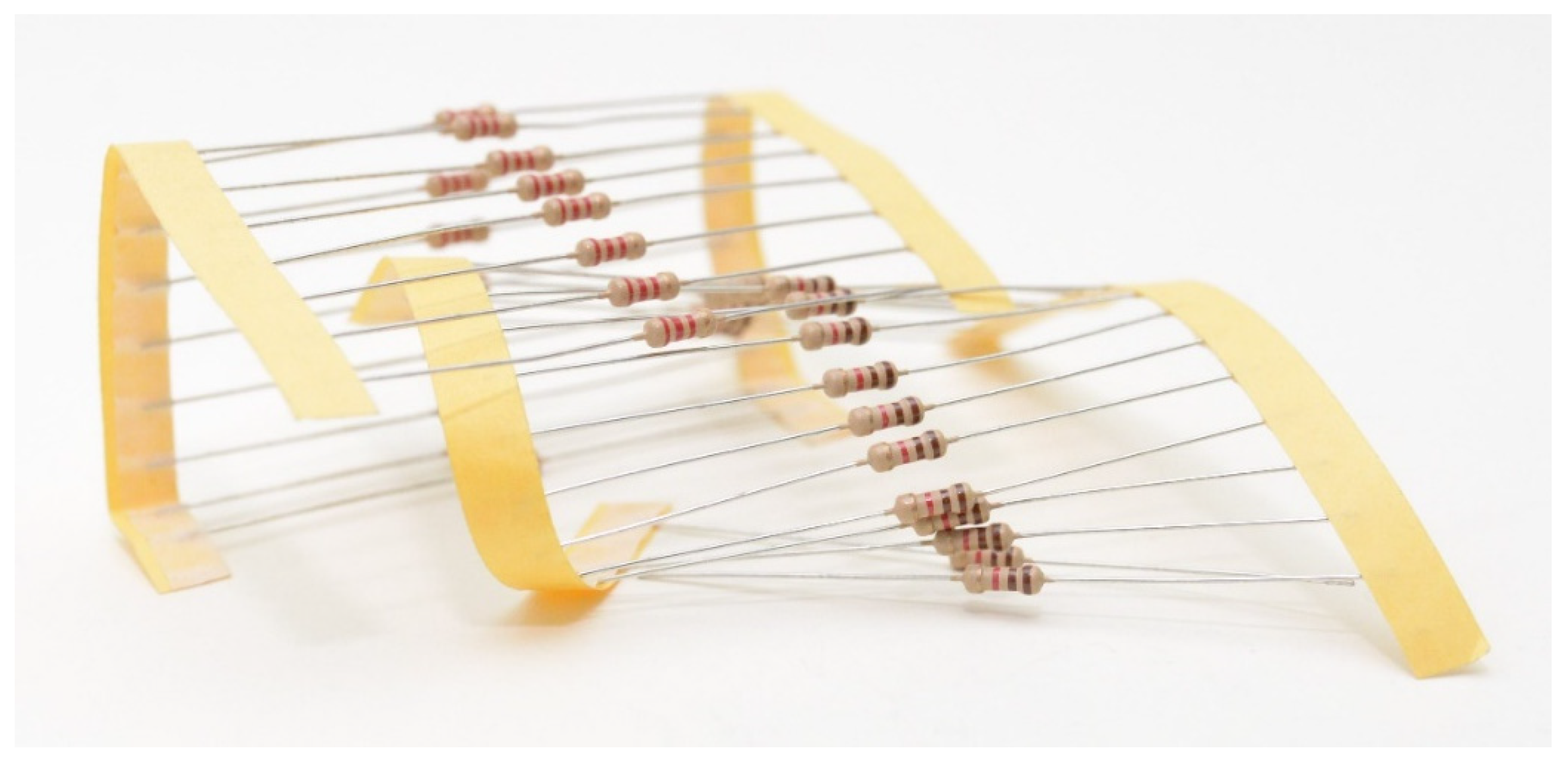

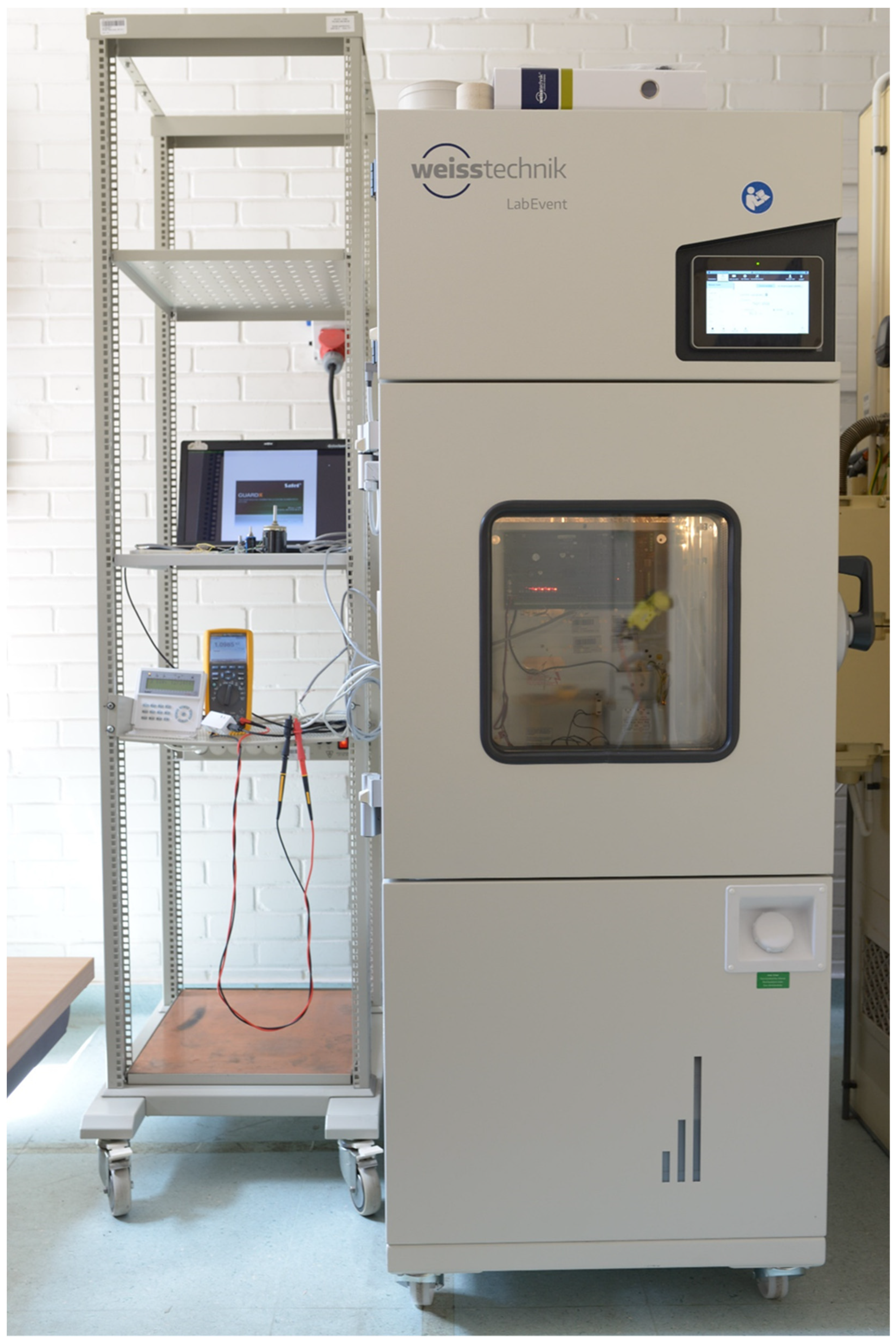

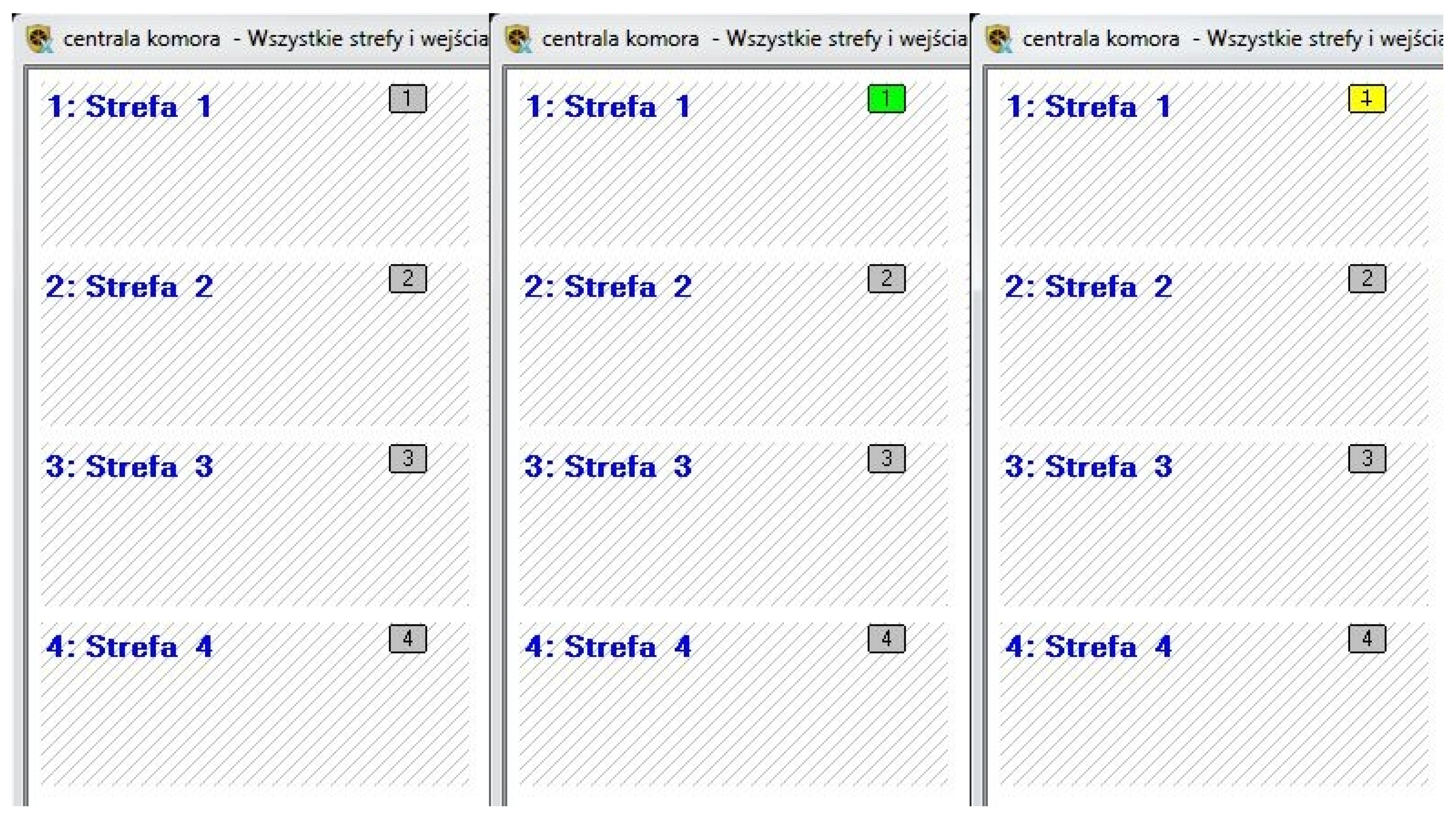
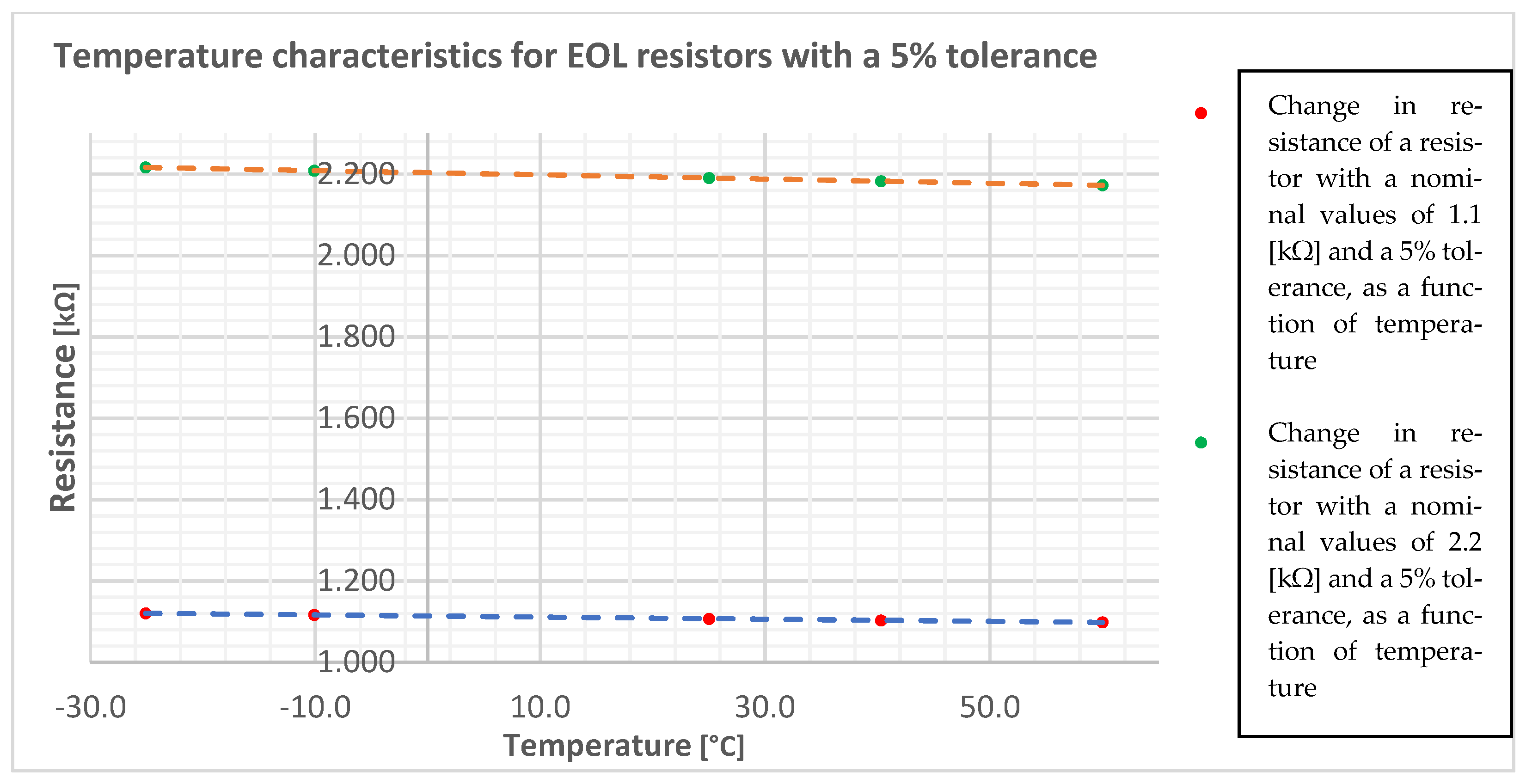
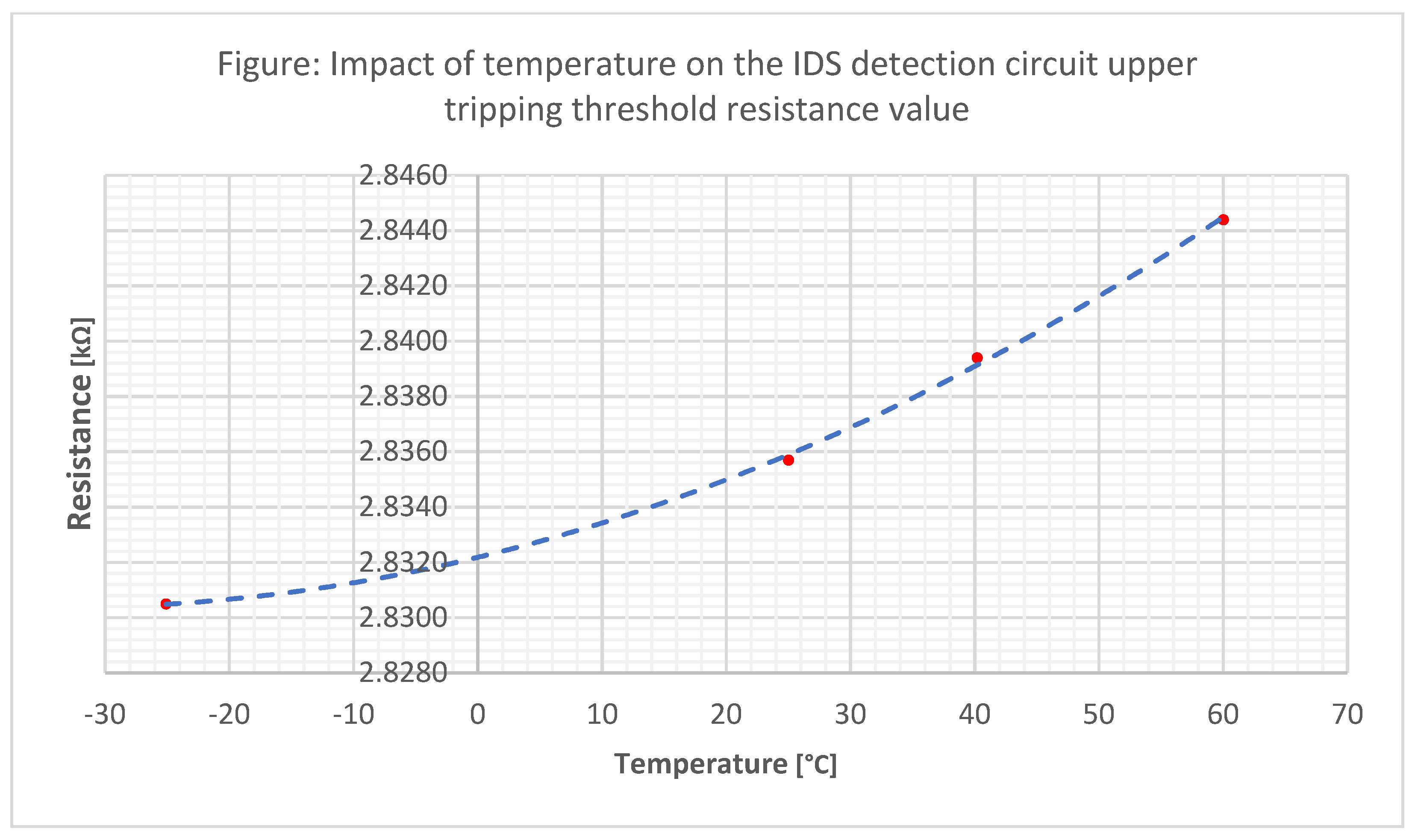

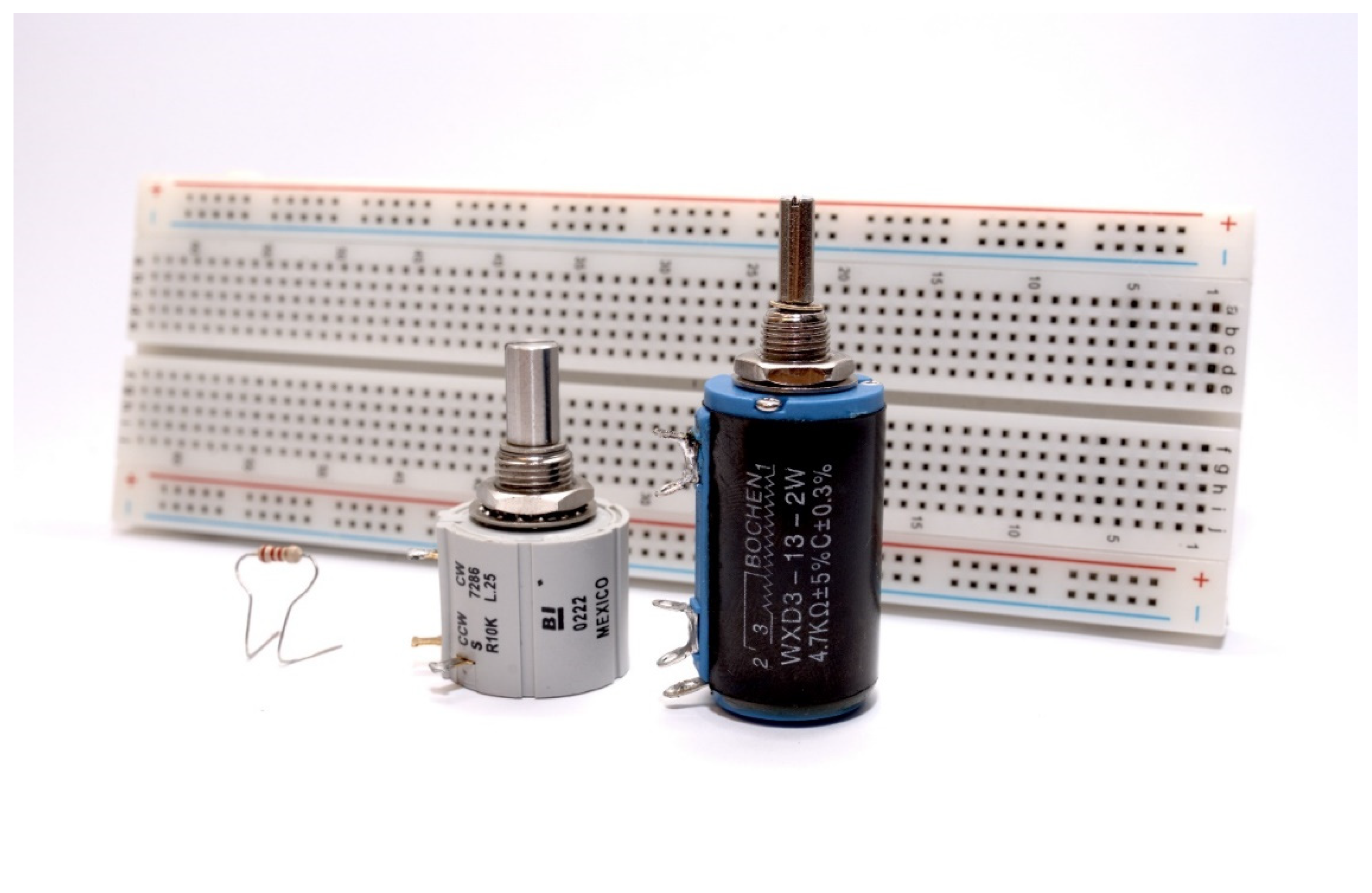
| Change in the resistance of a resistor with a nominal value of 1.1 [kΩ] and a 5% tolerance, as a function of temperature | |||||
| Resistance [kΩ] | 1.0985 | 1.1034 | 1.1075 | 1.1168 | 1.1207 |
| Temperature [°C] | 60.0 | 40.3 | 25.0 | −10.1 | −25.1 |
| Change of resistance from Tmin. to Tmax. [kΩ] | 0.0222 | ||||
| Change of resistance from 25.1 [°C] to 60.0 [°C] | 0.0090 | ||||
| Change of resistance from 25.0 [°C] to −25.1 [°C] | 0.0132 | ||||
| Change in the resistance of a resistor with a nominal value of 2.2 [kΩ] and a 5% tolerance, as a function of temperature | |||||
| Resistance [kΩ] | 2.1730 | 2.1825 | 2.1906 | 2.2089 | 2.2167 |
| Temperature [°C] | 60.0 | 40.3 | 25.0 | −10.1 | −25.1 |
| Change of resistance from Tmin. to Tmax. [kΩ] | 0.0437 | ||||
| Change of resistance from 25.1 [°C] to 60.0 [°C] | 0.0176 | ||||
| Change of resistance from 25.0 [°C] to −25.1 [°C] | 0.0261 | ||||
| Change in the resistance of a resistor with a nominal value of 1.1 [kΩ] resulting from manufacturing spread | Rmin. [Ω] | Rmax. [Ω] |
| 1045 | 1155 | |
| Change in the resistance of a resistor with a nominal value of 2.2 [kΩ] resulting from manufacturing spread | Rmin. [Ω] | Rmax. [Ω] |
| 2090 | 2310 |
| Resistor with a nominal value of 1.1 [kΩ] | ||
| Minimum and maximum resistance resulting from the minimum and maximum superpositions of manufacturing spread resistance and resistance changes at a minimum and maximum temperature | 1.0318 | 1.1640 |
| Resistor with a nominal value of 2.2 [kΩ] | ||
| Minimum and maximum resistance resulting from the minimum and maximum superpositions of manufacturing spread resistance and resistance changes at a minimum and maximum temperature | 2.0639 | 2.3276 |
| Temperature: 60.0 [°C] | Temperature: 40.2 ± 0.1 [°C] | Temperature: 25.0 ± 0.2 [°C] | Temperature: −25.1 ± 0.1 [°C] | ||||
|---|---|---|---|---|---|---|---|
| Resistance [kΩ] | Parametric Line State | Resistance [kΩ] | Parametric Line State | Resistance [kΩ] | Parametric Line State | Resistance [kΩ] | Parametric Line State |
| 2.8547 | A, A, A, A | 2.8549 | A, A, A, A | 2.8549 | A, A, A, A | 2.8554 | A, A, A, A |
| 2.8535 | A, A, A, A | 2.8534 | A, A, A, A | 2.8533 | A, A, A, A | 2.8533 | A, A, A, A |
| 2.8524 | A, A, A, A | 2.8525 | A, A, A, A | 2.8528 | A, A, A, A | 2.8528 | A, A, A, A |
| 2.8512 | A, A, A, NA | 2.8515 | A, A, A, A | 2.8516 | A, A, A, A | 2.8514 | A, A, A, A |
| 2.8496 | A, A, NA, A | 2.8498 | A, A, A, A | 2.8503 | A, A, A, A | 2.8501 | A, A, A, A |
| 2.8485 | A, A, A, A | 2.8484 | A, A, A, A | 2.8484 | A, A, A, A | 2.8486 | A, A, A, A |
| 2.8471 | A, NA, NA, NA | 2.8472 | A, A, A, A | 2.8476 | A, A, A, A | 2.8476 | A, A, A, A |
| 2.8457 | A, NA, NA, A | 2.8459 | A, A, A, A | 2.8463 | A, A, A, A | 2.8462 | A, A, A, A |
| 2.8444 | NA, NA, NA, NA | 2.8446 | A, A, A, A | 2.8449 | A, A, A, A | 2.8449 | A, A, A, A |
| 2.8432 | NA, NA, NA, NA | 2.8435 | A, A, A, A | 2.8436 | A, NA, A, A | 2.8436 | A, A, A, A |
| 2.8418 | NA, NA, NA, NA | 2.8421 | NA, A, A, NA | 2.8423 | A, A, A, A | 2.8422 | A, A, A, A |
| 2.8406 | NA, NA, NA, NA | 2.8408 | A, NA, NA, NA | 2.8410 | A, A, A, A | 2.8409 | A, A, A, A |
| 2.8391 | NA, NA, NA, NA | 2.8394 | NA, NA, NA, NA | 2.8391 | A, A, NA, A | 2.8396 | A, A, A, A |
| 2.8379 | NA, NA, NA, NA | 2.8379 | NA, NA, NA, NA | 2.8383 | NA, NA, NA, NA | 2.8383 | A, A, A, A |
| 2.8369 | NA, NA, NA, NA | 2.8368 | NA, NA, NA, NA | 2.8369 | NA, A, NA, NA | 2.8369 | A, A, A, A |
| 2.8352 | NA, NA, NA, NA | 2.8355 | NA, NA, NA, NA | 2.8357 | NA, NA, NA, NA | 2.8356 | A, A, A, A |
| 2.8339 | NA, NA, NA, NA | 2.8341 | NA, NA, NA, NA | 2.8343 | NA, NA, NA, NA | 2.8342 | NA, A, A, A |
| 2.8326 | NA, NA, NA, NA | 2.8329 | NA, NA, NA, NA | 2.8330 | NA, NA, NA, NA | 2.8330 | A, NA, A, NA |
| 2.8313 | NA, NA, NA, NA | 2.8316 | NA, NA, NA, NA | 2.8317 | NA, NA, NA, NA | 2.8317 | A, A, NA, NA |
| 2.8301 | NA, NA, NA, NA | 2.8303 | NA, NA, NA, NA | 2.8304 | NA, NA, NA, NA | 2.8305 | NA, NA, NA, NA |
| 2.8286 | NA, NA, NA, NA | 2.8282 | NA, NA, NA, NA | 2.8285 | NA, NA, NA, NA | 2.8290 | NA, NA, NA, NA |
| 2.8274 | NA, NA, NA, NA | 2.8277 | NA, NA, NA, NA | 2.8279 | NA, NA, NA, NA | 2.8278 | NA, NA, NA, NA |
| 2.8261 | NA, NA, NA, NA | 2.8263 | NA, NA, NA, NA | 2.8264 | NA, NA, NA, NA | 2.8264 | NA, NA, NA, NA |
| 2.8248 | NA, NA, NA, NA | 2.8246 | NA, NA, NA, NA | 2.8245 | NA, NA, NA, NA | 2.8237 | NA, NA, NA, NA |
| ⁞ | ⁞ | ⁞ | ⁞ | ⁞ | ⁞ | ⁞ | ⁞ |
| 2.2 | NA, NA, NA, NA | 2.2 | NA, NA, NA, NA | 2.2 | NA, NA, NA, NA | 2.2 | NA, NA, NA, NA |
| ⁞ | ⁞ | ⁞ | ⁞ | ⁞ | ⁞ | ⁞ | ⁞ |
| 1.5395 | NA, NA, NA, NA | 1.5397 | NA, NA, NA, NA | 1.5398 | NA, NA, NA, NA | 1.5397 | NA, NA, NA, NA |
| 1.5383 | NA, NA, NA, NA | 1.5384 | NA, NA, NA, NA | 1.5386 | NA, NA, NA, NA | 1.5385 | NA, NA, NA, NA |
| 1.5370 | NA, NA, NA, NA | 1.5371 | NA, NA, NA, NA | 1.5372 | NA, NA, NA, NA | 1.5372 | NA, NA, NA, NA |
| 1.5358 | NA, NA, NA, NA | 1.5359 | NA, NA, NA, NA | 1.5360 | NA, NA, NA, NA | 1.5359 | NA, NA, NA, NA |
| 1.5343 | NA, NA, NA, NA | 1.5345 | NA, NA, NA, NA | 1.5345 | NA, NA, NA, NA | 1.5345 | NA, NA, NA, NA |
| 1.5330 | NA, NA, NA, NA | 1.5332 | NA, NA, NA, NA | 1.5333 | NA, NA, NA, NA | 1.5333 | NA, NA, NA, NA |
| 1.5317 | NA, NA, NA, NA | 1.5319 | NA, NA, NA, NA | 1.5320 | NA, NA, NA, NA | 1.5320 | NA, NA, NA, NA |
| 1.5303 | NA, NA, NA, NA | 1.5306 | NA, NA, NA, NA | 1.5307 | NA, NA, NA, NA | 1.5307 | NA, NA, NA, NA |
| 1.5292 | NA, A, NA, A | 1.5293 | NA, NA, NA, NA | 1.5294 | NA, NA, NA, NA | 1.5294 | NA, NA, NA, NA |
| 1.5280 | A, A, A, A | 1.5280 | NA, NA, NA, NA | 1.5281 | NA, NA, NA, NA | 1.5281 | NA, NA, NA, NA |
| 1.5278 | NA, A, A, A | 1.5279 | NA, NA, NA, NA | 1.5280 | NA, NA, NA, NA | 1.5280 | NA, NA, NA, NA |
| 1.5266 | A, A, A, A | 1.5267 | A, A, A, NA | 1.5267 | NA, NA, NA, NA | 1.5267 | NA, NA, NA, NA |
| 1.5251 | A, A, A, A | 1.5255 | A, A, A, A | 1.5255 | NA, NA, NA, A | 1.5255 | NA, NA, NA, NA |
| 1.5239 | A, A, A, A | 1.5241 | A, A, A, A | 1.5241 | A, A, A, A | 1.5241 | A, A, A, A |
| 1.5226 | A, A, A, A | 1.5229 | A, A, A, A | 1.5229 | A, A, A, NA | 1.5228 | A, A, A, A |
| 1.5214 | A, A, A, A | 1.5215 | A, A, A, A | 1.5216 | A, A, A, A | 1.5214 | A, A, A, A |
| 1.5202 | A, A, A, A | 1.5203 | A, A, A, A | 1.5203 | A, A, A, A | 1.5202 | A, A, A, A |
| 1.5188 | A, A, A, A | 1.5189 | A, A, A, A | 1.5189 | A, A, A, A | 1.5189 | A, A, A, A |
| 1.5177 | A, A, A, A | 1.5177 | A, A, A, A | ||||
Publisher’s Note: MDPI stays neutral with regard to jurisdictional claims in published maps and institutional affiliations. |
© 2021 by the authors. Licensee MDPI, Basel, Switzerland. This article is an open access article distributed under the terms and conditions of the Creative Commons Attribution (CC BY) license (https://creativecommons.org/licenses/by/4.0/).
Share and Cite
Łukasiak, J.; Rosiński, A.; Wiśnios, M. The Impact of Temperature of the Tripping Thresholds of Intrusion Detection System Detection Circuits. Energies 2021, 14, 6851. https://doi.org/10.3390/en14206851
Łukasiak J, Rosiński A, Wiśnios M. The Impact of Temperature of the Tripping Thresholds of Intrusion Detection System Detection Circuits. Energies. 2021; 14(20):6851. https://doi.org/10.3390/en14206851
Chicago/Turabian StyleŁukasiak, Jarosław, Adam Rosiński, and Michał Wiśnios. 2021. "The Impact of Temperature of the Tripping Thresholds of Intrusion Detection System Detection Circuits" Energies 14, no. 20: 6851. https://doi.org/10.3390/en14206851
APA StyleŁukasiak, J., Rosiński, A., & Wiśnios, M. (2021). The Impact of Temperature of the Tripping Thresholds of Intrusion Detection System Detection Circuits. Energies, 14(20), 6851. https://doi.org/10.3390/en14206851








